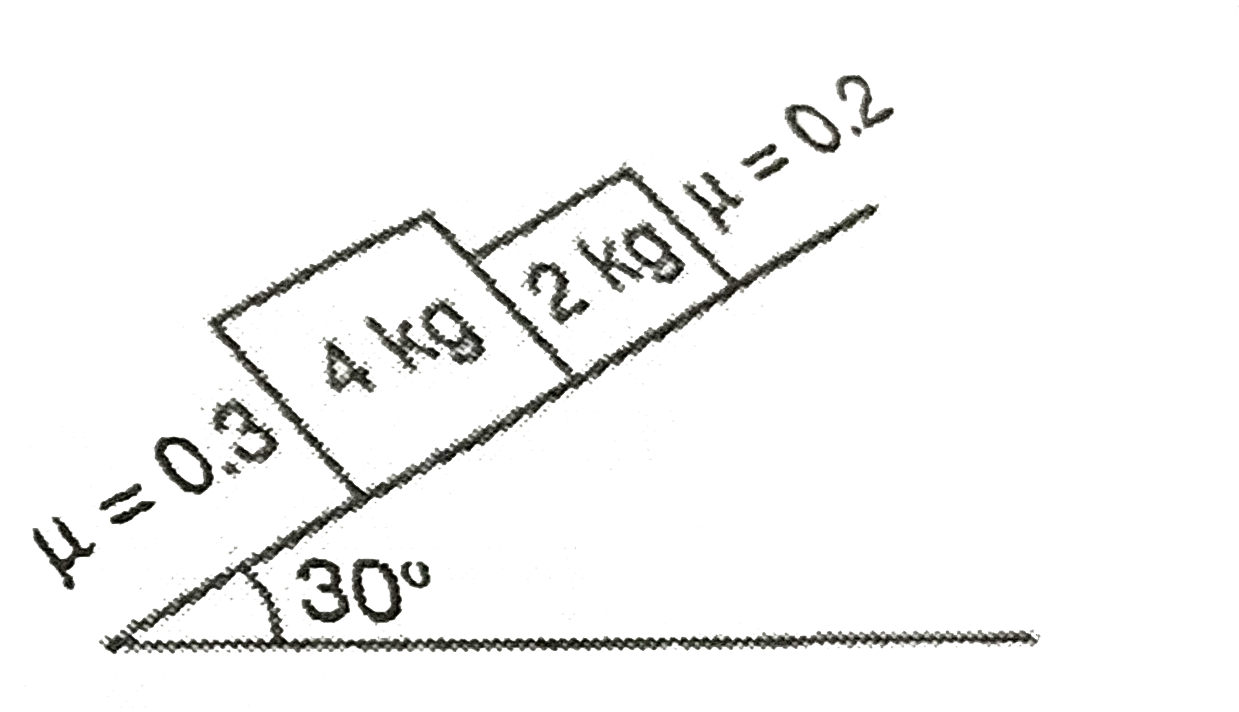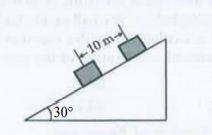A block of miss 2kg slides down a 30∘ incline which is 3.6m high At the bottom, it strikes a block or mass 6 kg which is at rest on a horizontall surface. If the colision is elastic, and friction can be ignored, determing (a) the speeds of the two blocks after the collision and (b) how far back up the incline the smaller mass will go.
The correct Answer is:[402m/s,4.2m/s,1.8malong incline]
Step by step video, text & image solution for A block of miss 2kg slides down a 30^(@) incline which is 3.6m high At the bottom, it strikes a block or mass 6 kg which is at rest on a horizontall surface. If the colision is elastic, and friction can be ignored, determing (a) the speeds of the two blocks after the collision and (b) how far back up the incline the smaller mass will go. by Physics experts to help you in doubts & scoring excellent marks in Class 11 exams.
Updated on:21/07/2023Topper's Solved these Questions
Similar Questions
In which o the following cases the centre of mass of a rod is certainly not at its centre?
View SolutionA block of mass 10 kg slides down a rough slope which is inclined at 45^(0) to the horizontal. The coeffficient of sliding friction is 0.30 . When the block has to slide 5m , the work done on the block by the force of friction is nearly
View SolutionA block of mass 10 kg is placed on an inclined plane when the angle of inclination is 30∘. The block just begins to slide down the plane. The force of static friction is
View SolutionA 1 kg block sIides down an inclined plane of mass 3.2kg having inclination 45^(@) . If the inclined plane is fixed and the 1kg block slides without friction, find the acceleration of the centre of mass of the system of the block and inclined plane.
View SolutionTwo blocks 4 kg and 2 kg are sliding down an incline plane as shown in fig The acceleration of 2 kg block is:

View SolutionA block of mass M slides down a rough inclined surface of inclination theta and reaches the bottom at speed at 'v' . However , if it slides down a smooth inclined surface of same length and same inclination , it reaches the bottom with the speed kv. Coefficient of friction between the block and the rough incline is :
View SolutionTwo blocks are connected over a massless pulley as shown in figure. The mass of block A is 10 kg and the coefficient of kinetic friction is 0.2 Block A sliders down the incline at constant speed. The mass of block B in kg is

View SolutionA block of mass 5 kg slides down a rough inclined surface. The angle of inclination is 45^(@) . The coefficient of sliding friction is 0.20. When the block slides 10 cm, the work done on the block by force of friction is
View SolutionTwo blocks 4 kg and 2 kg are sliding down an incline plane as shown in figure. The acceleration of 2 kg block is.
View SolutionA block mass 3 kg slides down a frictionless inclined plane of length 6 m and height 4 m. if the block is released from rest at the top of the incline, what is its speed at the bottom?
View SolutionTwo blocks are connected over massless pulley as shown in figure. The mass of block Ais 10 kg and the coefficient of kinetic friction is 0.2 .Block A sliders down the incline at constant speed. The mass of block B in kg is
View SolutionIn Fig. 6-49, two blocks are connected over a pulley. The mass of block A is 15 kg, and the coefficient of kinetic friction between A and the incline is 0.20 Angle theta of the incline is 30^(@) . Block A slides down the incline at constant speed. What is the mass of block B?
View SolutionA block of mass 2 kg slides down an incline plane of inclination 30°. The coefficient of friction between block and plane is 0.5. The contact force between block and plank is :
View SolutionA block of mass 0.5 kg has an initial velocity of 10ms−1 down an inclined plane of angle 30∘, the coefficient of friction between the block and the inclined surface is 0.2. The velocity of the block after it travels a distance of 10 m is

View SolutionA small block of mass M moves on a frictionless surface of an inclined plane, as shown in the figure. The angle of the incline suddenly changes from 60^(@) to 30^(@) at point B . The block is many at rest at A . Assume that collisions between the block id the incline are totally inelastic. The speed of the block at point B immediately after it strikes the second incline is
View Solution
